How to Send the Perfect Follow-Up SMS Text

No matter what business you’re in, there’s always a need for sending follow-up SMS messages. For example, maybe you want a business associate to consider your proposal, a customer to purchase the item they left in their cart, or a client to book an appointment after learning about your services. You may also want to check in after an initial phone call, double-check they didn’t miss your email, or gauge their interest following an important meeting.
And that’s where follow-up SMS text messages come in handy. Follow-up text messages to clients and customers are a polite way of gently nudging the recipient to do a specific task. These texts can help you get a reply, encourage a call to action, or further build your relationship.
Our guide below covers everything you need to know about sending a perfect follow-up SMS text message to a client or customer.
How to Send the Perfect Follow-Up SMS Text
Believe it or not, there’s a lot of finesse involved in crafting the ideal follow-up SMS text message after a meeting, phone call, or other interaction. You want to be polite and friendly without being too pushy or annoying. After all, there’s nothing worse than hounding someone who may not be interested in doing business with you or your company.
Let’s unpack the ins and outs of drafting a compelling follow-up text.
Importance of Follow-Up SMS Texts
Why is it important to send a follow-up SMS text? It’s important to send a follow-up text because it can help keep your message top-of-mind, show that you’re invested, and increase your chances of a response.
1. To Keep Your Message Top-of-Mind
Life gets busy and chaotic at times, making it easy for things to get lost. However, you don’t want to lose that big sale, proposal, or business opportunity just because things got busy for your customer or client. That’s why sending a follow-up text after an appointment, meeting, or phone call is important to ensure that the discussion topic stays in mind. It’s a gentle, non-invasive reminder that helps prevent that topic from getting forgotten or overlooked.
2. To Show That You're Invested
When you send a follow-up text message after a proposal or important meeting, it’s a sign that you’re invested and being proactive. This is especially crucial if you’re trying to move something along, like a business deal or sale. Sending a timely follow-up text message expresses that you’re prioritizing the topic.
3. To Increase the Chances of Getting a Response
How often have you forgotten to reply to an email or return someone’s phone call? If it’s happened to you, it could also happen to your customer or client. That’s why sending a polite follow-up text after a phone call or email conversation is a great way to jog their memory, put your conversation back on the table, and encourage them to take action.
When to Send a Follow-Up SMS Text
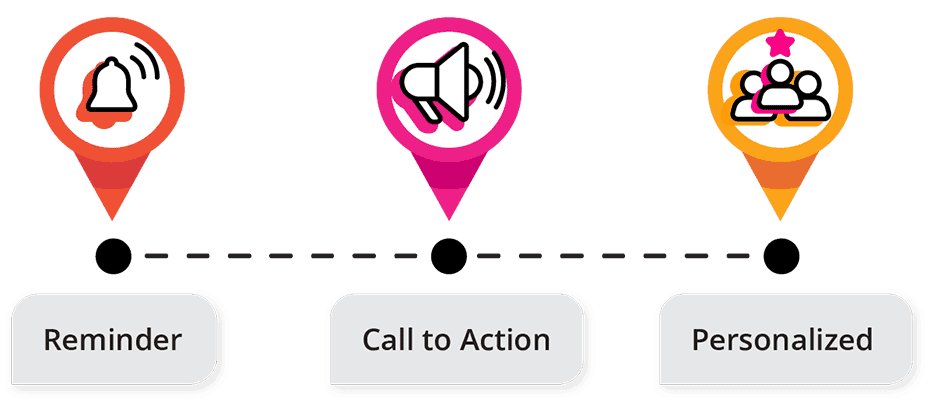
Now that you understand the importance of these messages, when should you send a follow-up text? There are a few instances when it’s appropriate to send a follow-up text message, including within 24 hours of your initial message, a few days after not hearing back, and then again in a week or two if you still haven’t received a reply.
For instance, it is a good idea to send a customer follow-up text within 24 hours of your initial contact.
So, if you just had a conversation in person, on the phone, or by email, you might send a quick message thanking them for taking the time to discuss and reminding them of the next steps.
If you don’t hear back after that first follow-up sales text, consider letting a few days go by before checking in again. You don’t want to bombard them, but a polite follow-up text can help get you back on their radar.
If it’s been a week or two, and you still haven’t received a response, you may want to send a final follow-up text to your client or customer.
At this point, you don’t want to come across as needy, annoying, or aggressive, so look at this as your last-ditch effort. If they don’t bite, you may have to cut your losses or wait until they’re ready to come to you.
What to Include in a Follow-Up SMS Text

Now, it’s time to learn how to optimize your copy and craft effective follow-up text messages. So, what should you include in your follow-up text? You should include a brief reminder of your initial message, a call to action, and a personalized touch.
1. A Brief Reminder of Your Initial Message
When sending a relevant follow-up text message to a client or customer, it helps to reference your previous communication. For example, you might remind them of the email you sent last week or your phone conversation earlier this month. Or, perhaps you’re reminding them about their interaction with your business, like if they abandoned their online shopping cart or signed up to receive your newsletter. Therefore, your sales follow-up text will remind your recipient of your prior engagement and provide you with a reason for following up.
2. A Call to Action
If you want to write an effective follow-up text message, including an SMS text call to action is crucial. Think about what it is you want your recipient to do. For instance, do you want them to make a purchase, close a deal, or provide you with feedback? Whatever it is, clarify why you’re following up and what you would like to happen next.
3. A Personalized Touch
A personalized follow-up text can go a long way because it shows you’re individually texting the recipient rather than just including them in a mass text. So, how should you personalize your follow-up text? You should personalize your follow-up text by using the recipient’s name, referring to something specific from your recent conversation or interaction, and clarifying why you’re texting them. Doing these three things can help get their attention and increase their chances of replying when they realize you took the time to write a custom message.
How to Write a Follow-Up SMS Text
At this point, you’re probably wondering how to format your follow-up text. Keep the following things in mind when formatting your text: keep it short, ensure your message is clear and concise, and avoid spammy practices.
1. Keep It Short
The most effective messages are short and simple. After all, your customer or client doesn’t have time to sit down and read a novel-length message. When writing your text, think of ways to get your message across in fewer words, ensuring your recipient can get the gist while scanning the content.
2. Use Clear and Concise Language
Don’t make the recipient need a dictionary to decipher your message. Instead, use clear and concise language so they can easily understand why you're contacting them.
3. Avoid Using Spammy Language and Practices
You want to avoid spammy practices when writing any kind of message to your customers or clients, but it’s vital when writing follow-up texts. How do you avoid sending spammy follow-up texts? You can prevent spammy follow-up texts by only sending messages to those who have expressed interest in your business, ensuring your messages are relevant and helpful, not using all caps or exclamation points, and avoiding grammatical errors.
4. Common Mistakes to Avoid
Now, what are some common mistakes to avoid when sending a follow-up text? Some common mistakes to avoid when sending a follow-up text include not sending one at all or sending one too soon, along with sending messages that are too long or short, too formal or informal, and too pushy or passive. Finding the right balance is the key to sending the perfect follow-up text message.
5. Not Sending a Follow-Up Text at All
Wayne Gretzky once said, “You miss 100% of the shots you don't take,” that’ll be the case for you if you’re not sending follow-up texts after interactions with your customers or clients. If you don’t send one, there’s a good chance your interaction could get lost in the shuffle and maybe even forgotten about.
6. Sending a Follow-Up SMS Text Too Soon
While being proactive is good, you don’t want to come across as too eager—or desperate. Give your customer or client breathing room before bombarding them with a follow-up message.
7. Sending a Follow-Up SMS Text That is Too Long or Too Short
You need to find a sweet spot regarding the length of your messages. If the text is too short, the recipient might find it too vague or not understand what you’re referencing, but if it’s too long, they may not even finish reading it.
8. Sending a Follow-Up SMS Text That is Too Formal or Too Informal
You’ll also want to know how formal or informal your messages are coming across to the recipient. For example, if the tone is too formal, it might confuse the recipient, and if it’s too informal, it could be off-putting.
9. Sending a Follow-Up SMS Text That is Too Pushy or Too Passive
How should you avoid being too pushy? You can avoid being too pushy by limiting the number of sales follow-up texts you send, not coming across as demanding or aggressive, and giving the recipient time to respond. However, you don’t want to be too passive either, so send at least one message with a polite yet clear call to action.
10. Handling No Responses
Even if you follow all these tips, there’s still a chance your message may get left on read. So, how should you handle no response? There are a few ways to handle no response, which include sending one final follow-up text, not taking it personally, and then moving on if you still don’t hear back. Remember that it’s a numbers game—the more client and customer follow-up text messages you send, the higher your chances are of getting responses.
11. Understand Tracking
The last piece to this puzzle involves tracking your results. This means monitoring the reporting and analytics features that provide you with performance data and metrics, such as how many follow-up texts you’ve sent, how many have been opened, and how many recipients have responded. This is crucial to your follow-up strategy because it helps you stay organized and prevents you from over- or under-messaging your clients and customers.
Furthermore, when you grasp how your follow-up strategy is performing, you can experiment with different timing and content to see if you can improve your response rates.
Examples of Follow-Up SMS Texts
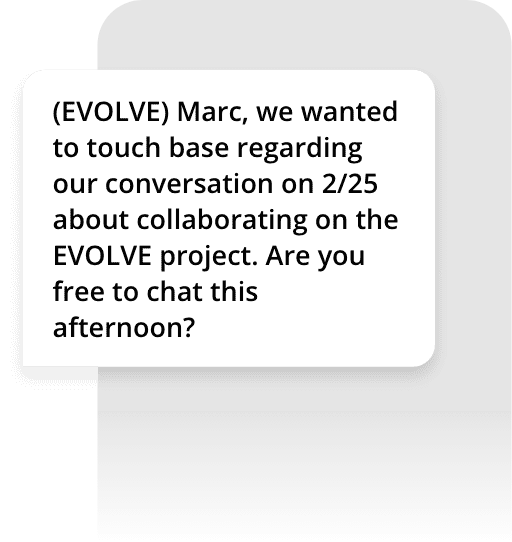
Now that you understand how and when to write a follow-up text, let’s look at some examples.
One common example of a follow-up text is when you want to re-engage with a customer, client, or colleague after an initial interaction.
For instance, maybe you need to reconnect after an exploratory conversation about partnering on a project. Therefore, your follow-up message might look like this: “(EVOLVE) Marc, we wanted to touch base regarding our conversation on 2/25 about collaborating on the EVOLVE project. Are you free to chat this afternoon?”
Or, perhaps you want to encourage a customer to purchase the items they abandoned in their online shopping cart. In this case, you might send a follow-up SMS message saying, “(Lux Skincare) Uh-oh! It looks like you left some Lux Skincare items in your online shopping cart! Click here to complete your purchase.”
Another instance following an initial interaction might be if a customer inquired about your business, providing you with an opportunity to gauge their interest in your services. For example, “(CC’s Salon) Jess, thank you for contacting us about our salon services. Would you like to book an appointment?” Or, (CC’s Salon) Jess, thank you for inquiring about our salon services. Are you interested in booking a haircut with us?”
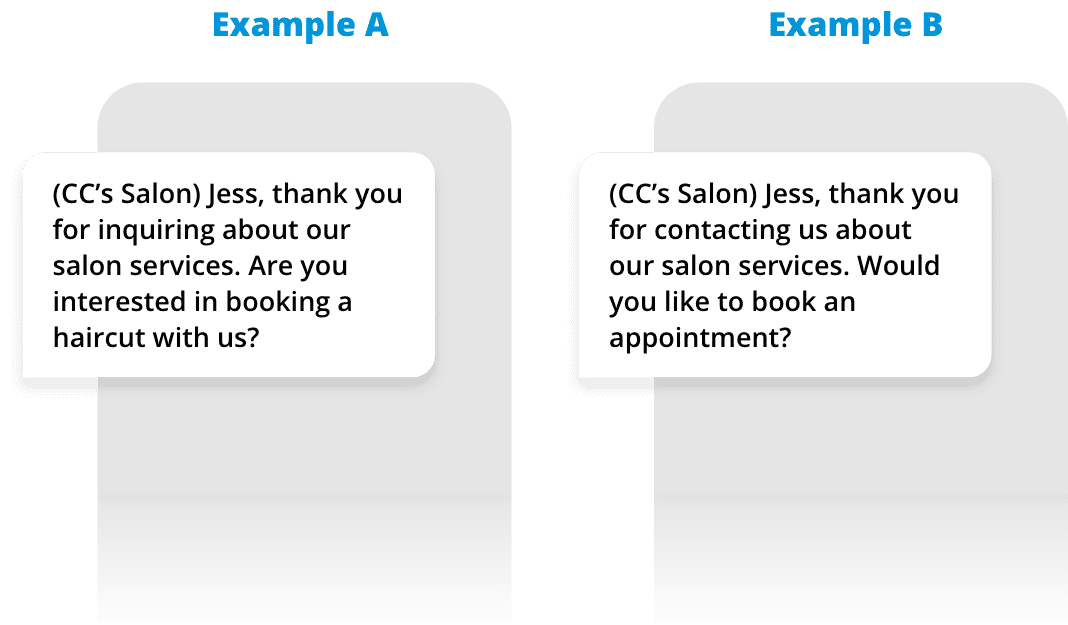
You can also use follow-up SMS texts to gently remind someone to take action.
Let’s say you’re a real estate agent, and a potential buyer expressed interest in viewing a property but has since gone silent. In this scenario, you could send a reminder saying something like, “(Jim’s Real Estate) Drew, the 122 Farms Lane property is still available. Would you like me to arrange a tour for you?” Or, if you wanted to make it more urgent, you might send a follow-up that says, “Jim’s Real Estate) Drew, I’m getting a lot of calls about the 122 Farms Lane property—it’s going to go fast! Do you want to schedule a tour?”
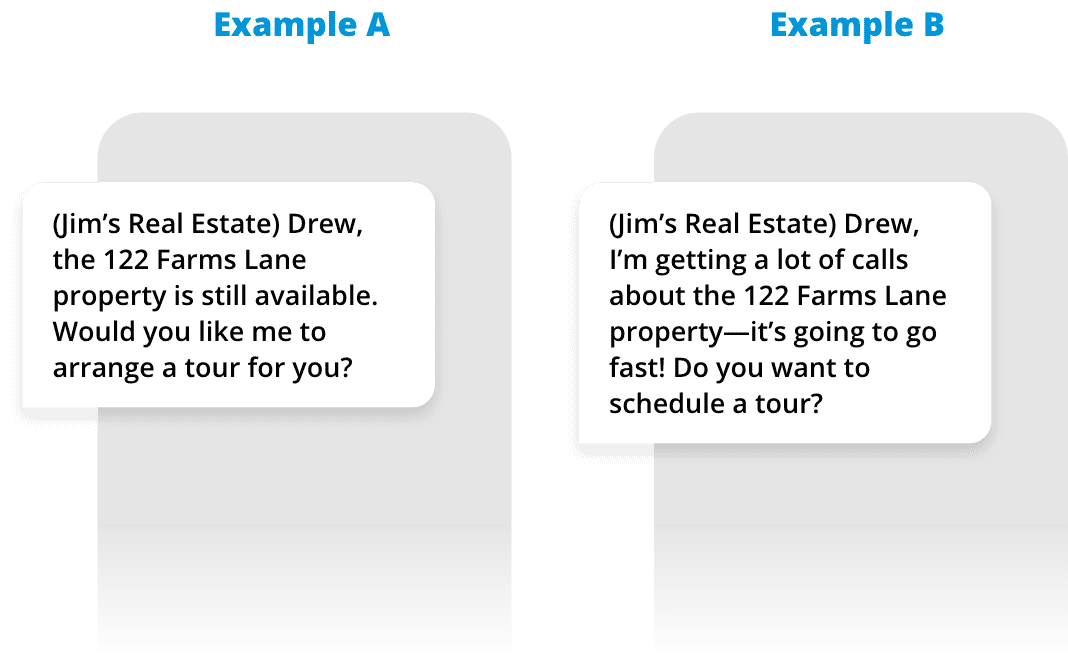
In a similar scenario, you might use a follow-up text to confirm a previously discussed appointment. For example, “(PR Co) Alex, we mentioned discussing the AZ account this Friday. Are you still available to meet at 3 pm?” Or, “(PR Co) Alex, I wanted to confirm you’re still available to chat on Friday at 3 pm to discuss the AZ account. If so, I’ll send you a meeting invite.”

Furthermore, you can use follow-up text messages to provide status updates or offer additional information.
For example, maybe you need to follow up with a customer after they inquired about their shipment. In this case, you could text them with a message like, “(Camping Depot) Chris, we received your message regarding your shipment. We shipped your package on 11/12. Please click here for tracking updates.
Alternatively, maybe you and your client keep playing phone tag, so you want to follow up with more information, such as “(Top Biz) Jules, I’m following up on your voicemail. Please click here to find the data you requested.” Or, “(Top Biz) Jules, just following up with you because I keep missing your calls. I’ll send you a meeting invite to discuss this topic further.”
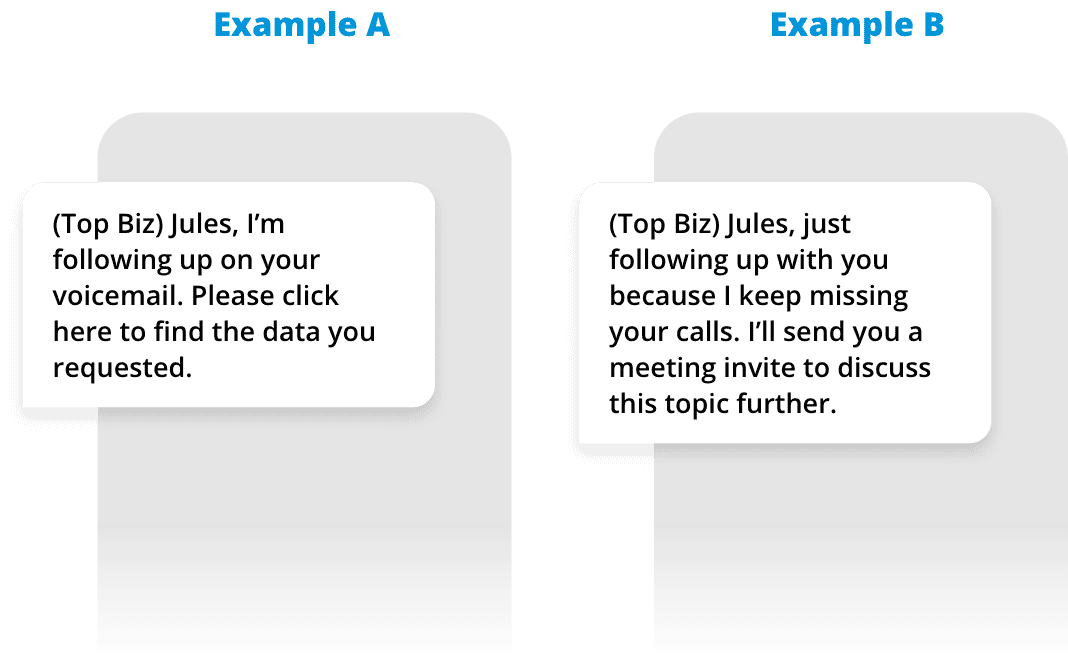
As you can see, there are countless scenarios in which a follow-up text can come in handy!
Start Sending Perfect Follow-Up SMS Marketing Texts Today
Ready to put what you’ve learned to the test? Sign up for our free 14-day trial and start sending your follow-up texts!
See other resources related to:
